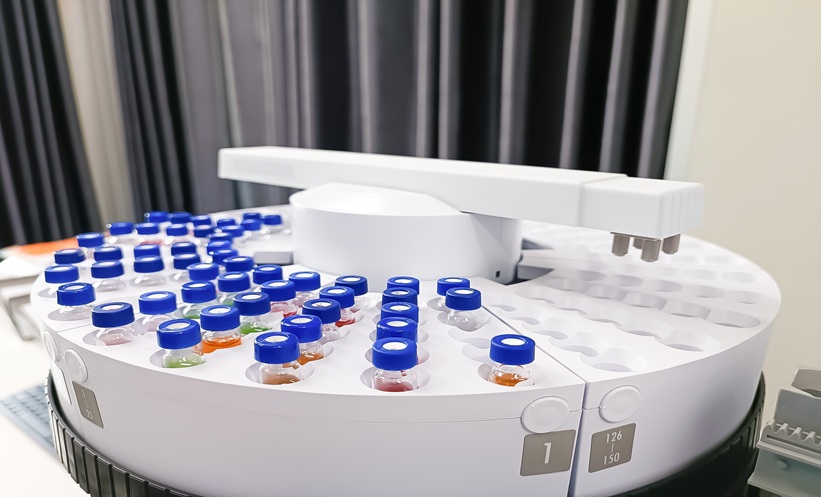Glucagon-like Peptide-1 Drugs Linked to Lower Obesity-Related Cancer Risk
GLUCAGON-like peptide-1 receptor agonists (GLP-1RA) are already widely prescribed for Type 2 diabetes and weight management, but they may also offer protection against obesity-related cancers, according to a large real-world study presented at the 2025 ASCO Annual Meeting.1
Researchers examined whether GLP-1RAs, which induce weight loss, could reduce the risk of developing obesity-related cancers in adults with both obesity and Type 2 diabetes. They compared cancer incidence in patients newly prescribed GLP-1RAs versus those prescribed dipeptidyl peptidase-4 inhibitors, which are weight-neutral diabetes drugs. The study included 85,015 adults from 43 U.S. health systems between 2013–2023. Patients in both groups were matched 1:1 on age (mean: 56.8 years), year of prescription, and other clinical characteristics using propensity scores.
After an average follow-up of 3.9 years, GLP-1RA users had a significantly lower risk of obesity-related cancers compared to dipeptidyl peptidase-4 inhibitors users (adjusted hazard ratio: 0.93; 95% CI: 0.88–0.98; p=0.005). In addition, the GLP-1RA group had a reduced risk of all-cause mortality (adjusted hazard ratio: 0.92; 95% CI: 0.87–0.97; p=0.001). Subgroup analysis revealed protective effects particularly for colon and rectal cancers, suggesting that GLP-1RAs may confer specific tumor-related benefits beyond general metabolic improvements.
This study adds to growing evidence that GLP-1RAs may play a broader role in disease prevention, particularly in patients with high metabolic risk profiles. Further prospective trials are needed to confirm these findings and explore the mechanisms underlying the apparent anticancer effects of GLP-1-based therapies.
App Boosts Wellbeing in Caregivers of Stem Cell Transplant Recipients
A DIGITAL mental health app has been shown to significantly improve quality of life and reduce psychological distress in caregivers of patients undergoing hematopoietic stem cell transplant (HSCT), according to a new randomized trial presented at the 2025 ASCO Annual Meeting.2
Caring for patients receiving HSCT places severe emotional and psychological demands on relatives, yet few interventions have addressed their needs in an accessible format. This single-center trial tested the efficacy of the BMT-CARE App, a self-guided digital tool offering psychoeducation, behavior change strategies, and stress management via interactive modules. A total of 125 adult caregivers of HSCT recipients at a tertiary U.S. cancer center were randomized 1:1 to receive access to the app or usual care, stratified by transplant type. Participants completed outcome measures at baseline and 60 days post-transplant.
Caregivers who used the BMT-CARE App reported significantly better quality of life at 60 days (mean CareGiver Oncology Quality of Life score: 76.2 versus 69.9; p=0.006), surpassing the clinically meaningful 5-point threshold. The app group also showed lower caregiving burden (11.2 versus 12.3; p=0.024), fewer depressive symptoms (3.8 versus 5.6; p=0.002), and fewer PTSD symptoms (26.0 versus 31.3; p=0.011), compared with usual care. Additionally, coping skills were significantly improved in the intervention group (33.9 versus 28.2; p=0.003). However, no significant differences were observed in anxiety symptoms or self-efficacy at follow-up. The average user spent just over 2 hours with the app across the study period.
These results suggest that digital psychosocial interventions can be effective, scalable tools to support caregivers in high-stress oncology settings. Broader implementation may ease the burden on clinical support services while improving outcomes for carers.
Stereotactic Radiation Reduces Symptoms in Patients with Multiple Brain Metastases
A PHASE III randomized trial, presented at the 2025 ASCO Annual Meeting, has found that stereotactic radiation (SRS/SRT) offers superior quality of life outcomes compared to hippocampal avoidance whole brain radiation therapy (HA-WBRT) in patients with 5–20 brain metastases.3
The multicenter study, conducted between April 2017–May 2024, enrolled 196 patients and is the first to directly compare these two advanced radiation approaches in this patient population.
Historically, SRS/SRT has shown better symptom control in patients with up to four brain metastases, while HA-WBRT has improved cognitive outcomes over traditional WBRT. However, evidence has been lacking in patients with more extensive metastatic disease.
Participants, aged 18–80 and with no prior brain-directed radiation or leptomeningeal disease, were randomized to receive either SRS/SRT or HA-WBRT. The trial’s primary endpoint was the average change in symptom severity and functional interference over 6 months, using the validated MD Anderson Symptom Inventory Brain Tumor module.
Results demonstrated significantly lower symptom severity and functional interference in the SRS/SRT group compared to the HA-WBRT group. The difference in symptom severity was -0.62 (p<0.001), and in interference was -1.50 (p<0.001). Median survival was similar between groups (8.3 versus 8.5 months; p=0.30), confirming no detriment to overall survival.
These findings support the use of SRS/SRT as the new standard of care for patients with 5–20 brain metastases, prioritizing quality of life without sacrificing survival.
Abemaciclib Shows Promise in Treating Kaposi Sarcoma, Regardless of HIV Status
A PHASE I/II clinical trial presented at the 2025 ASCO Annual Meeting has found that abemaciclib, a CDK4/6 inhibitor currently approved for breast cancer, demonstrates encouraging activity in patients with Kaposi sarcoma (KS), including those living with HIV. The study suggests a potential new therapeutic option for this virus-associated malignancy.4
KS is driven by Kaposi sarcoma herpesvirus and occurs in both HIV-positive and HIV-negative individuals. Preclinical research has indicated that CDK4/6 inhibitors may enhance immune responses to Kaposi sarcoma herpesvirus-infected cells, prompting investigators to evaluate abemaciclib’s efficacy and safety in this setting.
The two-stage, open-label trial enrolled 34 participants (33 men; median age: 43 years), 74% of whom were people with HIV (PWH) with well-controlled viral loads. In Phase I, six patients received 200 mg of abemaciclib twice daily for days 1–28 of a 28-day cycle. Phase II included 28 patients across two arms: those with previously treated KS (n=17) and those who were treatment naïve (n=10).
Among the 31 evaluable participants who received more than two cycles, 77% achieved a partial response, with response rates of 76% and 80% in pretreated and untreated patients, respectively. Stable disease was seen in four patients, while two progressed. Common side effects included diarrhea (92%) and elevated creatinine (64%), with neutropenia prompting dose reductions in 13 patients.
These results highlight abemaciclib as a well-tolerated and effective treatment option for KS, particularly in those without prior systemic therapy. Further studies are warranted to confirm these findings and explore long-term outcomes.
Perioperative Therapy Fails to Improve Survival in Colorectal Peritoneal Metastases
PERIOPERATIVE systemic therapy does not improve overall survival compared to surgery alone in patients with resectable colorectal peritoneal metastases undergoing cytoreductive surgery with hyperthermic intraperitoneal chemotherapy (CRS-HIPEC), according to a multicenter Phase III trial presented at the 2025 ASCO Annual Meeting.5
Colorectal peritoneal metastases represent a challenging clinical scenario, and CRS-HIPEC is the standard of care for selected patients with resectable disease. However, the potential benefit of adding perioperative systemic chemotherapy to this approach has remained uncertain, with no prospective randomized data available until now.
The CAIRO6 multicenter Phase III trial addressed this gap by randomizing 358 patients with resectable colorectal peritoneal metastases and no recent systemic therapy to receive either perioperative systemic therapy (capecitabine and oxaliplatin; 5-fluorouracil/leucovorin with either oxaliplatin, or irinotecan; with neoadjuvant bevacizumab) plus CRS-HIPEC, or CRS-HIPEC alone. Of these, 351 patients were eligible for the primary analysis: 173 in the perioperative systemic therapy group and 178 in the surgery alone group. The primary endpoint was overall survival, with secondary endpoints including progression-free survival and 90-day postoperative morbidity and mortality.
At a median follow-up of 41 months, median overall survival was 44 months in the perioperative systemic therapy group and 39 months in the surgery alone group, with 3-year overall survival rates of 54% and 53%, respectively (hazard ratio [HR] for death: 0.85; 95% CI: 0.62–1.15; p=0.28). While progression-free survival was longer in the perioperative systemic therapy group (median 13.5 months versus 7.0 months; HR: 0.51; 95% CI: 0.41–0.65), this did not translate into a statistically significant improvement in overall survival. In patients who underwent complete CRS-HIPEC, the difference in 3-year overall survival was also not statistically significant (64% versus 59%; HR: 0.73; 95% CI: 0.51–1.05). Major postoperative morbidity within 90 days was higher in the perioperative systemic therapy group (36% versus 26%), while 90-day mortality was 1% in both groups.
These results suggest that, for patients with resectable colorectal peritoneal metastases, adding perioperative systemic therapy to CRS-HIPEC does not confer a survival advantage and is associated with increased morbidity. In clinical practice, CRS-HIPEC alone remains the standard of care, and the routine use of perioperative systemic therapy should be reconsidered for this patient group.
Escalating Chemotherapy Based on Circulating Tumor DNA Does Not Improve Colon Cancer Outcomes
TREATMENT escalation based on circulating tumor DNA (ctDNA) positivity does not improve recurrence-free survival compared to standard adjuvant chemotherapy in patients with Stage III colon cancer, according to a primary analysis of the DYNAMIC-III study, which was presented at the 2025 ASCO Annual Meeting.6
Recurrence remains a significant concern for patients with Stage III colon cancer, even after standard adjuvant chemotherapy. Recent advances have identified ctDNA as a potent prognostic biomarker, with detectable ctDNA after surgery indicating a higher risk of recurrence. The DYNAMIC-III trial sought to determine whether intensifying adjuvant chemotherapy in patients who are ctDNA-positive could improve outcomes, potentially ushering in a more personalized approach to post-surgical management.
In this multicenter, randomized Phase II/III trial, 961 patients with resected Stage III colon cancer were enrolled and randomly assigned to either ctDNA-informed management or standard of care. Of these, 259 patients (27%) were ctDNA-positive 5 to 6 weeks after surgery. In the ctDNA-informed group, 89% of patients received escalated chemotherapy, with 56% receiving the intensive 5-fluorouracil, leucovorin, oxaliplatin, and irinotecan regimen. In the standard care group, 86% received oxaliplatin-based doublet therapy, and 11% received single-agent fluoropyrimidine. The primary outcome was 2-year recurrence-free survival (RFS).
After a median follow-up of 42.2 months, 2-year RFS was 52% (90% CI: 44–59%) in the ctDNA-informed escalation group and 61% (90% CI: 54–68%) in the standard care group, with a hazard ratio of 1.11 (90% CI: 0.83–1.48; p=0.6), indicating no significant benefit from treatment escalation. Three-year RFS was also similar between those receiving 5-fluorouracil, leucovorin, oxaliplatin, and irinotecan; and those on doublet therapy (47% versus 51%). Importantly, a pre-specified analysis revealed that recurrence risk increased markedly with higher ctDNA burden, with 3-year RFS dropping from 78% in the lowest quartile to 22% in the highest. The analysis also revealed that rates of treatment-related hospitalization were similar between groups.
These findings confirm that while ctDNA positivity is a powerful prognostic marker, escalating chemotherapy based on ctDNA status alone does not improve survival outcomes in Stage III colon cancer. For clinical practice, ctDNA should be recognized as an important tool for risk stratification, but current evidence does not support intensifying adjuvant therapy solely on the basis of ctDNA positivity.
New Drug Combination Offers Longer Life for Patients with Cancer
A RECENT Phase III trial, TRIPLETE (NCT03231722), presented at the ASCO Annual Meeting 2025, evaluated the efficacy of two first-line treatment regimens in patients with unresectable RAS and BRAF wild-type metastatic colorectal cancer.7
Participants were randomly assigned to receive either standard FOLFOX combined with panitumumab (Arm A) or a modified, more intensive 5-fluorouracil, leucovorin, oxaliplatin, and irinotecan regimen with panitumumab (Arm B). While initial results showed no improvement in the primary endpoint of overall response rate, nor benefits in progression-free survival, early tumor shrinkage, or resection rates, new findings now reveal an overall survival (OS) advantage with the intensified treatment.
A total of 435 patients were enrolled (Arm A: n=217; Arm B: n=218), with well-balanced baseline characteristics. After a median follow-up of 60.2 months, 292 OS events had occurred. The results showed a statistically significant improvement in median OS for patients in Arm B, who lived a median of 41.1 months compared to 33.3 months in Arm A (hazard ratio: 0.79; 95% CI: 0.63–0.99; p=0.049). However, this OS benefit was not supported by any difference in progression-free survival (12.4 months in Arm A versus 12.7 months in Arm B; p=0.606), but was instead associated with longer post-progression survival (hazard ratio: 0.73; 95%CI: 0.57–0.93; p=0.012).
Subsequent therapies and exposure to key agents were similar between arms, though slightly more patients in Arm A received anti-angiogenic drugs and irinotecan after disease progression. Despite the higher toxicity linked to the intensified regimen, these findings suggest that upfront modified 5-fluorouracil, leucovorin, oxaliplatin, and irinotecan with panitumumab may provide a meaningful survival benefit in this patient population; warranting consideration in clinical decision-making, despite the lack of early treatment activity advantages.
AI Model Shows Promise in Cancer Risk Prediction
A RECENT study, presented at the ASCO Annual Meeting 2025, explored the potential of the generative AI model o1 to summarize medical records and estimate sentinel lymph node (SLN) metastasis risk in patients with early-stage breast cancer.8
Accurately predicting SLN metastasis can help inform decisions about omitting axillary surgical staging, and nomograms from institutions like MD Anderson Cancer Center (MDACC), Houston, Texas, USA, and Memorial Sloan Kettering Cancer Center (MSKCC), New York, USA have been widely used for this purpose. In this study, researchers evaluated how well o1 could interpret pathology and radiology reports and apply this information to generate SLN metastasis risk estimates using these nomograms.
Twenty de-identified patient cases were provided to the o1-preview model, along with access to the MDACC and MSKCC nomogram calculators. Three test conditions were used: o1 applied the nomogram unaided; then with serial corrections to the output after each case; and finally, generated estimates without any nomogram. Results from 120 comparisons were analyzed against manually calculated nomogram outputs.
Without correction, o1 identified nomogram variables accurately in 60% of cases; this improved to 85% with SC. When no nomogram was used, o1 correctly identified 96% of relevant variables, typically using 7–9 per case. However, issues arose in estimating tumor size, which impacted prediction accuracy. Only once did o1 fabricate data, hallucinating a tumor size; but more often, it selected suboptimal tumor measurements.
Across all scenarios, o1 precisely estimated SLN metastasis risk in just 4 cases (3.3%). Estimates were more frequently underestimated, particularly without serial corrections or nomogram guidance. The average deviation from manual calculations was also greater without nomogram use.
Though the AI model showed strong capabilities in summarizing complex medical data, its predictive accuracy was limited by nuanced clinical details. The findings suggest promise, but highlight the need for continued refinement before AI tools like o1 can be fully relied upon in clinical settings.
Telehealth Music Therapy Matches Cognitive Behavioral Therapy for Anxiety in Cancer Survivors
A NEW clinical trial presented at ASCO 2025, showed compelling evidence that music therapy (MT), delivered via telehealth, is non-inferior to cognitive behavioral therapy (CBT) for reducing anxiety in cancer survivors.9
The study aimed to recognize the prevalence and impact of anxiety in these patients who face barriers in accessing traditional CBT, and to evaluate whether MT could offer a scalable, acceptable alternative.
The trial enrolled 300 adult cancer survivors with persistent anxiety (≥1 month duration), representing various cancer types and stages. Participants were randomized 1:1 to receive either MT or CBT, each delivered in seven weekly sessions through Zoom, with follow-up assessments at Weeks 8 and 26. The primary outcome was change in anxiety scores on the Hospital Anxiety and Depression Scale (HADS), while secondary measures included depression, fatigue, insomnia, pain, cognitive function, and quality of life.
Findings showed that MT achieved anxiety reductions comparable to CBT at both time points. At Week 8, the mean HADS anxiety reduction was –3.12 points in the MT group versus –2.97 in the CBT group, with a negligible between-group difference of –0.15, well within the predefined non-inferiority margin. Similarly, at Week 26, the difference (–0.31 points) remained within the margin, supporting MT’s sustained effectiveness. Both groups also demonstrated improvements across secondary outcomes, with reductions in anxiety that exceeded the minimum clinically important difference.
Importantly, these results highlight the potential for MT to expand therapeutic options for anxiety management in cancer survivorship. Delivered remotely via standardized protocols, both MT and CBT offer accessible, scalable interventions capable of addressing the diverse needs of people with cancer.
Phase III Trial Supports Olanzapine for Preventing Radiotherapy-Induced Nausea and Vomiting
A LARGE Phase III trial presented at the ASCO 2025 Annual Meeting has provided strong evidence for repurposing olanzapine as an effective preventive strategy against radiotherapy-induced nausea and vomiting in patients undergoing abdominal or pelvic radiotherapy.10
The study was conducted between February 2022–August 2024, and aimed to assess whether the addition of 5 mg daily olanzapine to standard antiemetic care (ondansetron) could improve symptom control compared to placebo.
A total of 301 patients were randomized: 148 to the olanzapine arm and 153 to placebo. Participants represented a mix of cancer types, including rectal, prostate, endometrial, and pancreatic cancers. Both groups were well matched in demographics, radiotherapy technique, and chemotherapy use.
The findings were notable. Patients receiving olanzapine reported significantly higher rates of “no nausea” (85.8% versus 16.3%) and “no vomiting” (95.9% versus 74.5%) during radiotherapy compared to placebo (both p<0.001). Fewer patients in the olanzapine group required rescue therapy (1.4% versus 7.8%; p=0.008), and severe nausea (Grade ≥2) was dramatically reduced (7.4% versus 67%; p=0.001). Subgroup analyses showed particularly strong benefits in patients with rectal or prostate cancer.
While olanzapine was associated with mild side effects such as drowsiness, dysarthria, and orthostatic hypotension, it also appeared to reduce anxiety, depression scores, and improve sleep. Quality of life outcomes favored olanzapine for domains related to emotional function, nausea/vomiting, appetite loss, and insomnia.
In conclusion, this well-powered trial demonstrates that low-dose olanzapine offers substantial protection against radiotherapy-induced nausea and vomiting, suggesting it should be considered as part of routine supportive care in abdominal and pelvic radiotherapy. Further research may explore optimal dosing and long-term safety.





